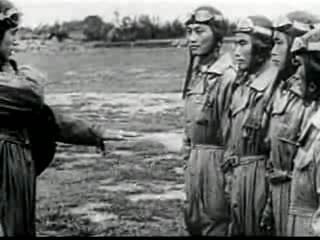 W
WThe Second Sino-Japanese War began on 7 July 1937 with the Marco Polo Bridge Incident in the Republic of China and is often regarded as the start of World War II as full-scale warfare erupted with the Battle of Shanghai, and ending when the Empire of Japan surrendered to the Allies in August 1945. The Chinese Air Force faced the Imperial Japanese Army and Navy Air Forces and engaged them in many aerial interceptions, including the interception of massed terror-bombing strikes on civilian targets, attacking on each other's ground forces and military assets in all manners of air-interdiction and close-air support; these battles in the Chinese skies were the largest air battles fought since the Great War, and featured the first-ever extensive and prolonged deployment of aircraft carrier fleets launching preemptive strikes in support of expeditionary and occupational forces, and demonstrated the technological shift from the latest biplane fighter designs to the modern monoplane fighter designs on both sides of the conflict.
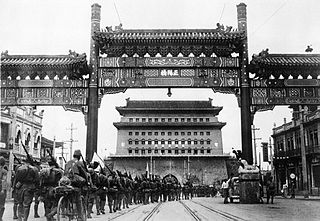 W
WThe Battle of Beiping–Tianjin, also known as the Battle of Beiping, Battle of Peiping, Battle of Beijing, Battle of Peiking, the Peiking-Tientsin Operation, and by the Japanese as the North China Incident was a series of battles of the Second Sino-Japanese War fought in the proximity of Beiping and Tianjin. It resulted in a Japanese victory.
 W
WBattle of Northern Burma and Western Yunnan was the name of the Chinese campaign with their allies in the 1943–45 Burma Campaign. The campaign ended in an Allied victory.
 W
WThe Canton Operation was part of a campaign by Japan during the Second Sino-Japanese War to blockade China to prevent it from communicating with the outside world and importing needed arms and materials. Control of Guangzhou (Canton) and the Pearl River Delta would provide a base to make the blockade of Guangdong province more effective by seizing southern China's major port and isolate the British port of British Hong Kong.
 W
WOperation Chahar, known in Chinese as the Nankou Campaign, occurred in August 1937, following the Battle of Beiping-Tianjin at the beginning of Second Sino-Japanese War.
 W
WThe Battle of Changde was a major engagement in the Second Sino-Japanese War in and around the Chinese city of Changde (Changteh) in the province of Hunan. During the battle, the Imperial Japanese Army extensively used chemical weapons.
 W
WThe Battle of Changsha of 1944 was an invasion of the Chinese province of Hunan by Japanese troops near the end of the Second Sino-Japanese War. As such, it encompasses three separate conflicts: an invasion of the city of Changsha and two invasions of Hengyang.
 W
WThe First Battle of Changsha was the first of four attempts by Japan to take the city of Changsha, Hunan, during the second Sino-Japanese War. It was the first major battle of the war to fall within the time frame of what is widely considered World War II.
 W
WThe Battle of Changsha was Japan's second attempt at taking the city of Changsha, China, the capital of Hunan Province, as part of the Second Sino-Japanese War.
 W
WThe third Battle of Changsha was the first major offensive in China by Imperial Japanese forces following the Japanese attack on the Western Allies.
 W
WThe bombing of Chongqing, from 18 February 1938 to 23 August 1943, were massive terror bombing operations authorized by the Empire of Japan's Imperial General Headquarters and conducted by the Imperial Japanese Army Air Service (IJAAF) and Imperial Japanese Navy Air Service (IJNAF). Resistance was put up by the Chinese Air Force and the National Revolutionary Army's anti-aircraft artillery units in defense of the provisional wartime capital of Chongqing and other targets in Sichuan.
 W
WThe Defense of Sihang Warehouse took place from October 26 to November 1, 1937, and marked the beginning of the end of the three-month Battle of Shanghai in the opening phase of the Second Sino-Japanese War. Defenders of the warehouse held out against numerous waves of Japanese forces and covered Chinese forces retreating west during the Battle of Shanghai.
 W
WThe defense of the Great Wall was a campaign between the armies of Republic of China and Empire of Japan, which took place before the Second Sino-Japanese War officially commenced in 1937. It is known in Japanese as Operation Nekka and in many English sources as the First Battle of Hopei.
 W
WThe Hainan Island Operation, or Kainan-tō sakusen (海南島作戦) in Japanese, was part of a campaign by the Empire of Japan during the Second Sino-Japanese War to blockade the Republic of China and prevent it from communicating with the outside world as well as to prevent imports of much-needed arms and materials.
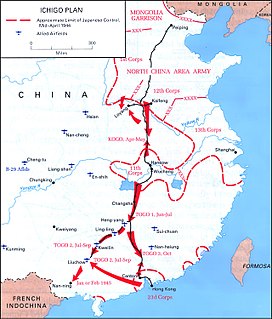 W
WOperation Ichi-Go was a campaign of a series of major battles between the Imperial Japanese Army forces and the National Revolutionary Army of the Republic of China, fought from April to December 1944. It consisted of three separate battles in the Chinese provinces of Henan, Hunan and Guangxi.
 W
WThe Hundred Regiments Offensive also known as the Hundred Regiments Campaign was a major campaign of the Communist Party of China's National Revolutionary Army divisions commanded by Peng Dehuai against the Imperial Japanese Army in Central China. The battle had long been the focus of propaganda in the history of Chinese Communist Party but had become Peng Dehuai's "crime" during the Cultural Revolution. Certain issues regarding its launching and consequences are still controversial.
 W
WThe Japanese invasion of French Indochina was a short undeclared military confrontation between Japan and France in northern French Indochina. Fighting lasted from 22 to 26 September 1940; the same time as the Battle of South Guangxi in the Sino-Japanese War, which was the main objective as to why Japan occupied Vietnam during this time.
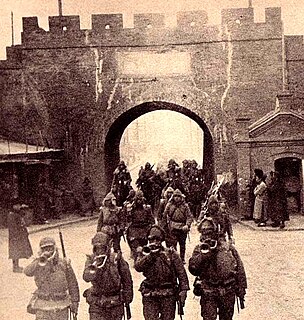 W
WThe Japanese invasion of Manchuria began on 18 September 1931, when the Kwantung Army of the Empire of Japan invaded Manchuria immediately following the Mukden Incident. At war's end in February 1932, the Japanese established the puppet state of Manchukuo. Their occupation lasted until the success of the Soviet Union and Mongolia with the Manchurian Strategic Offensive Operation in mid-August 1945.
 W
WThe Jiangqiao campaign was a series of battles and skirmishes occurring after the Mukden Incident, during the invasion of Manchuria by the Imperial Japanese Army, prior to the Second Sino-Japanese War.
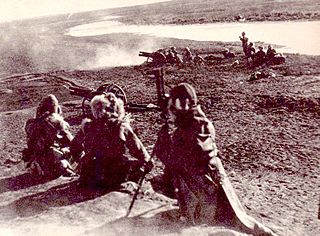 W
WThe Jinzhou Operation or Chinchow Operation was an operation in 1931 during the Japanese invasion of Manchuria, which was a preliminary, contributing factor to the outbreak of the Second Sino-Japanese War in 1937.
 W
WThe Marco Polo Bridge Incident, also known as the Lugou Bridge Incident or the Double-Seven Incident, was a July 1937 battle between China's National Revolutionary Army and the Imperial Japanese Army.
 W
WThe Battle of Mount Song, also known as the Battle of Ramou (拉孟の戦い), in 1944 was part of a larger campaign in southwest China during the Second World War. Chinese Nationalist forces aimed to retake the Burma Road.
 W
WThe Mukden Incident, or Manchurian Incident, known in Chinese as the 9.18 Incident (九・一八), was a false flag event staged by Japanese military personnel as a pretext for the 1931 Japanese invasion of Manchuria.
 W
WThe Battle of Nanchang was a military campaign fought around Nanchang, Jiangxi between the Chinese National Revolutionary Army and the Japanese Imperial Japanese Army in the Second Sino-Japanese War. It was the first major conflict to occur following the Battle of Wuhan.
 W
WThe Battle of Nanking was fought in early December 1937 during the Second Sino-Japanese War between the Chinese National Revolutionary Army and the Imperial Japanese Army for control of Nanking (Nanjing), the capital of the Republic of China.
 W
WThe Resistance at Nenjiang Bridge was a small battle fought between forces of the Chinese National Revolutionary Army against the Imperial Japanese Army and collaborationist forces, after the Mukden Incident during the Invasion of Manchuria in 1931, prior to the start of the Second Sino-Japanese War. It marked the start of the Jiangqiao Campaign.
 W
WThe Northrop Gamma was a single-engine all-metal monoplane cargo aircraft used in the 1930s. Towards the end of its service life, it was developed into the A-17 light bomber.
 W
WThe Pacification of Manchukuo was a Japanese counterinsurgency campaign to suppress any armed resistance to the newly established puppet state of Manchukuo from various anti-Japanese volunteer armies in occupied Manchuria and later the Communist Northeast Anti-Japanese United Army. The operations were carried out by the Imperial Japanese Kwantung Army and the collaborationist forces of the Manchukuo government from March 1932 until 1942, and resulted in a Japanese victory.
 W
WThe Battle of Pingxingguan, commonly called the Great Victory of Pingxingguan in Mainland China, was an engagement fought on September 25, 1937, at the beginning of the Second Sino-Japanese War, between the Eighth Route Army of the Communist Party of China and the Imperial Japanese Army.
 W
WThe proposed Japanese invasion of Sichuan, also known as the Sichuan invasion, Szechwan invasion, Chongqing Operation, Chongqing Campaign or Operation 5, was the Imperial Japanese Army's failed plan to destroy the Republic of China during the Second Sino-Japanese War. It was to be a stepping stone for the Empire of Japan's final control of the Chinese mainland.
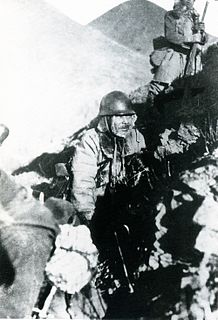 W
WThe Battle of Rehe was the second part of Operation Nekka, a campaign by which the Empire of Japan successfully captured the Inner Mongolian province of Rehe from the Chinese warlord Zhang Xueliang and annexed it to the new state of Manchukuo. The battle was fought from February 21 to March 1, 1933.
 W
WThe Battle of Shanggao, also called Operation Kinkō, was one of the 22 major engagements between the National Revolutionary Army and Imperial Japanese Army during the Second Sino-Japanese War.
 W
W19th Route Army was an army in the Republic of China led by General Cai Tingkai. It gained a good reputation among Chinese for fighting the Japanese in Shanghai in the January 28 Incident in 1932. In 1933-34 it was the main force in the Fuijan Rebellion, which opposed Chiang Kai-shek and unsuccessfully sought an alliance with the Chinese Communists in the Jiangxi Soviet.
 W
WThe January 28 incident or Shanghai incident was a conflict between the Republic of China and the Empire of Japan. It took place in the Shanghai International Settlement which was under international control. Japanese army officers, defying higher authorities, had provoked anti-Japanese demonstrations in the international District of Shanghai following the Japanese invasion of Manchuria. The Japanese government sent a sect of militant ultranationalist Japanese Buddhist priests belonging to the Nichiren sect to Shanghai. The monks were shouting anti-Chinese, pro-Japanese nationalist slogans in Shanghai, promoting Japanese rule over East Asia. In response, a Chinese mob formed killing one monk and injuring two. In response, the Japanese in Shanghai rioted and burned down a factory, killing two Chinese. Heavy fighting broke out, and China appealed with no success to the League of Nations. A truce was finally reached on May 5, calling for Japanese military withdrawal, and an end to Chinese boycotts of Japanese products.
 W
WThe Battle of Shanghai was the first of the twenty-two major engagements fought between the National Revolutionary Army (NRA) of the Republic of China (ROC) and the Imperial Japanese Army (IJA) of the Empire of Japan at the beginning of the Second Sino-Japanese War. It lasted from August 13, 1937, to November 26, 1937, and was one of the largest and bloodiest battles of the entire war, later described as "Stalingrad on the Yangtze", and is often regarded as the battle where World War II started. After over three months of extensive fighting on land, in the air and at sea, the battle concluded with a victory for Japan.
 W
WThe Battle of South Shanxi, also known as the Battle of Jinnan and Zhongtiao Mountains campaign by the Chinese and as the Chungyuan Operation by the Japanese, was one of the 22 major engagements between the National Revolutionary Army and the Imperial Japanese Army during the Second Sino-Japanese War (1937–1945).
 W
WThe Battle of Suixian–Zaoyang, also known as the Battle of Suizao was one of the 22 major engagements between the National Revolutionary Army (NRA) and Imperial Japanese Army (IJA) during the Second Sino-Japanese War. The Japanese launched a major two-pronged offensive that captured many cities and towns. However, their failure to defend against a series of coordinated Chinese counter-attacks forced them to completely withdraw, resulting in territorial control returning to the original status quo.
 W
WThe Suiyuan campaign was an attempt by the Inner Mongolian Army and Grand Han Righteous Army, two forces founded and supported by Imperial Japan, to take control of the Suiyuan province from the Republic of China. The attempted invasion occurred in 1936, shortly before the Second Sino-Japanese War. The Japanese government denied taking part in the operation, but the Inner Mongolians and the other collaborationist Chinese troops received air support from Japanese planes and were assisted by the Imperial Japanese Army. The entire operation was overseen by Japanese staff officers. The campaign was unsuccessful, mostly due to lack of training and low morale among the Mongolians and other collaborators. The defense of Suiyuan, one of the first major successes of China's National Revolutionary Army over Japanese-supported forces, greatly improved Chinese morale.
 W
WThe Battle of Tai'erzhuang was a battle of the Second Sino-Japanese War in 1938, between the armies of the Republic of China and the Empire of Japan. The battle was the first major Chinese victory of the war. It humiliated the Japanese military and its reputation as an invincible force, while for the Chinese it represented a tremendous morale boost.
 W
WThe Battle of Wanjialing, known in Chinese text as the Victory of Wanjialing, refers to the Chinese Army's successful engagement during the Wuhan theatre of the Second Sino-Japanese War against the Japanese 101st, 106th, 9th and 27th divisions around the Wanjialing region in 1938. The two and a half month battle resulted in heavy losses of the Japanese 101st and 106th Divisions.
 W
WThe Battle of West Hubei, was one of 22 major engagements between the National Revolutionary Army and Imperial Japanese Army during the Second Sino-Japanese War. It was also one of four major battles that took place in Hubei.
 W
WThe Battle of West Suiyuan was part of the Second Sino-Japanese War. It was fought from January – February 1940, as part of the Chinese 1939 Winter Offensive.
 W
WThe Battle of Wuhan (武漢之戰), popularly known to the Chinese as the Defense of Wuhan, and to the Japanese as the Capture of Wuhan, was a large-scale battle of the Second Sino-Japanese War. Engagements took place across vast areas of Anhui, Henan, Jiangxi, Zhejiang, and Hubei provinces over a period of four and a half months. It was the longest, the largest, and arguably the most significant battle in the early stages of the Second Sino-Japanese War. More than one million National Revolutionary Army troops from the Fifth and Ninth War Zone were put under the direct command of Chiang Kai-shek, defending Wuhan from the Central China Area Army of the Imperial Japanese Army led by Shunroku Hata. Chinese forces were also supported by the Soviet Volunteer Group, a group of volunteer pilots from Soviet Air Forces.
 W
WThe Battle of Wuyuan was a Chinese counterattack that defeated the Japanese invasion of the Wuyuan area. This happened in reaction to the Chinese 1939-40 Winter Offensive in Suiyuan during the Second Sino-Japanese War. The Japanese call it 第2次後套作戦.
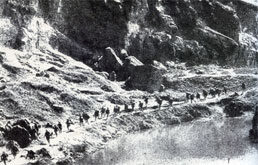 W
WThe Battle of Xinkou was a decisive engagement of the Taiyuan Campaign, the second of the 22 major engagements between the National Revolutionary Army and Imperial Japanese Army during the Second Sino-Japanese War.
 W
WThe Battle of Zaoyang–Yichang, also known as the Battle of Zaoyi, was one of the 22 major engagements between the National Revolutionary Army and Imperial Japanese Army during the Second Sino-Japanese War.
 W
WThe Zhejiang-Jiangxi campaign, also known as Operation Sei-go, was a campaign by the China Expeditionary Army of the Imperial Japanese Army under Shunroku Hata and Chinese 3rd War Area forces under Gu Zhutong in the Chinese provinces of Zhejiang and Jiangxi from mid May to early September 1942.